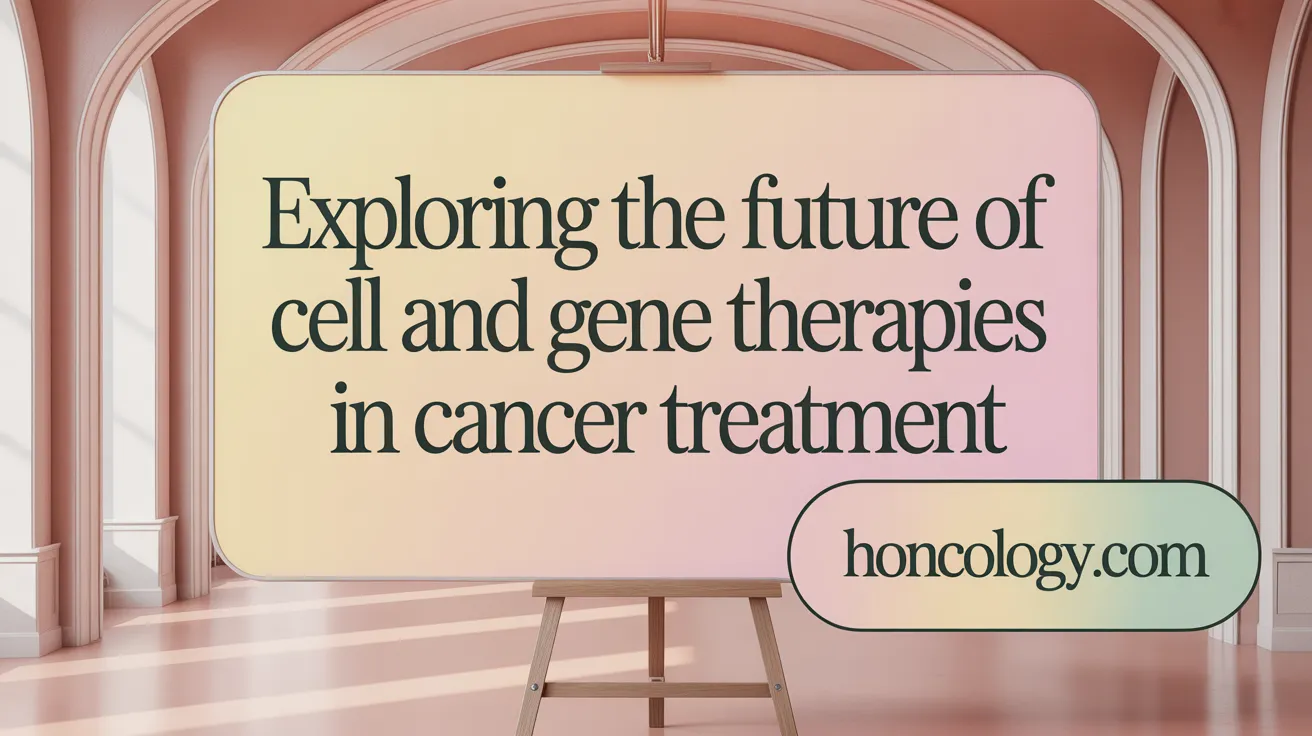Introduction to Cutting-Edge Cancer Therapies
Overview of Emerging Technologies in Cancer Treatment
The fight against cancer is rapidly evolving with breakthrough technologies transforming traditional care into more targeted, effective treatments. Recent innovations include personalized cancer vaccines developed using mRNA technology, which precisely target tumor-specific mutations to boost immune responses with fewer side effects. Gene-editing tools like CRISPR enable precise DNA modifications to reprogram immune cells or tumor behaviors, offering new therapeutic paths. Immunotherapies, such as CAR T-cell treatments, genetically modify immune cells to attack cancer specifically, demonstrating remarkable success particularly in blood cancers. Meanwhile, antibody-drug conjugates deliver chemotherapeutic agents directly into cancer cells, sparing healthy tissues.
Digital and AI technologies further enhance this landscape by improving early detection, predicting treatment responses, and assisting in clinical decisions through sophisticated data analysis. Advanced radiotherapy techniques like proton and carbon ion therapy provide precision targeting to minimize collateral tissue damage. Additionally, nano- and micro-scale drug delivery systems allow controlled and localized treatment release, reducing toxicity.
The Evolving Landscape of Cancer Care Combining Traditional and Innovative Approaches
Despite these cutting-edge advances, traditional methods remain integral to comprehensive cancer treatment plans. Surgery, chemotherapy, and radiation continue to be foundational, often combined with new therapies to maximize efficacy and minimize adverse effects. For example, immunotherapy is frequently paired with chemotherapy or targeted drugs to enhance treatment outcomes. Personalized medicine leverages genomic and molecular profiling to tailor treatments uniquely to each patient’s tumor signature, balancing efficacy and safety.
Clinics and research centers are increasingly adopting multi-disciplinary strategies where integrative approaches merge established protocols with experimental therapies and precision medicine innovations. Such combinations improve survival rates, reduce recurrence risks, and maintain quality of life. This dynamic fusion of old and new represents a promising horizon for oncology, offering hope and expanding options for patients worldwide.
Precision Oncology: Tailoring Treatments Through Genomic Insights
Role of genetic and molecular profiling in cancer treatment
Precision oncology focuses on understanding the unique genetic and molecular makeup of each cancer to create personalized cancer vaccines. By analyzing cancer tumor DNA sequencing and molecular characteristics, clinicians can select therapies that specifically target the cancer’s abnormalities. This approach contrasts with traditional treatments that often affect healthy cells, offering a more precise, effective, and less toxic strategy.
Impact of the 100,000 Genomes Project and large-scale tumor sequencing
Large-scale sequencing efforts like the UK's 100,000 Genomes Project and analysis of over 12,000 tumors globally have transformed cancer care. These initiatives provided extensive genomic data that help identify mutational signatures in cancer and reveal cancer drivers. This wealth of information allows for the identification of actionable targets and development of novel therapies tailored to genetic profiles, dramatically improving treatment specificity.
Tailored therapies reducing side effects and improving outcomes
Targeted therapies emerging from precision oncology advances minimize harm to healthy tissues by honing in on specific cancer mutations. Drugs such as PARP inhibitors and targeted therapies, kinase inhibitors, and novel immunotherapies are selected based on molecular insights, leading to improved effectiveness and reduced side effects. Personalized treatment not only enhances patient quality of life but also improves survival rates by preventing overtreatment and resistance development.
Personalized Cancer Vaccines and Immunotherapy Innovations

What are personalized cancer vaccines and how are they developed?
Personalized cancer vaccines use messenger RNA (mRNA cancer vaccines) technology to create treatments specifically tailored to an individual's tumor genetic profile. This approach primes the immune system to recognize and attack cancer cells based on unique mutations present in a patient’s tumor. Several clinical trials across Europe—including the UK cancer trials, Germany, Belgium, Spain, and Sweden—are testing these vaccines, with promising results showing enhanced immune response, reduced cancer recurrence, and fewer side effects compared to conventional therapies.
How are immune checkpoint inhibitors and CAR-T therapies advancing cancer treatment?
Immune checkpoint inhibitors, such as nivolumab and pembrolizumab, block molecules that suppress immune activation, enabling the body’s own T-cells to detect and destroy cancer cells more effectively. CAR-T cell therapy involves genetically modifying a patient’s T-cells to target specific cancer antigens, proving highly effective in blood cancers with remission rates up to 80% in some lymphomas. Innovations are ongoing to extend CAR-T approaches to solid tumors like breast and pancreatic cancer, focusing on reducing toxicity and overcoming tumor resistance.
What new therapeutic vaccines target specific tumor mutations like KRAS?
A significant breakthrough includes vaccines targeting KRAS mutations found in pancreatic and colorectal cancers. For instance, Memorial Sloan Kettering (MSK) conducted trials demonstrating safety and immune activation from such vaccines, which are designed to provoke a robust T-cell response specifically against mutated KRAS proteins, common drivers of aggressive tumors.
How do combination immunotherapy strategies enhance treatment efficacy?
Combining immune checkpoint inhibitors with other agents such as chemotherapy, targeted therapies, or additional immunomodulators has shown synergistic effects, improving patient outcomes. For example, the combination of immune checkpoint blockade with chemotherapy before surgery in cervical cancer drastically reduces recurrence risks. Additionally, CAR-T cell therapies are being paired with costimulatory molecules to enhance persistence and anti-tumor activity. These combination approaches aim to overcome resistance mechanisms and enhance the immune system’s ability to eradicate cancer cells.
Artificial Intelligence Revolutionizing Cancer Detection and Treatment

How is AI transforming early cancer detection and risk prediction?
Artificial intelligence is revolutionizing cancer care by enabling earlier and more accurate cancer detection. AI models analyze large datasets including medical records and imaging to identify patterns that human clinicians might miss. For example, AI algorithms developed at MIT lung cancer prediction can predict lung cancer risk up to six years before diagnosis using low-dose CT scans. In settings with limited specialist access, such as parts of India, AI assists in cancer risk profiling with AI and analyzing X-rays to facilitate early diagnosis.
What are the key applications of AI in imaging, genomics, and liquid biopsies?
AI technologies enhance the interpretation of medical images (CT, MRI, PET, ultrasound, digital pathology) using deep learning to detect tumors more precisely. Radiomics in cancer imaging—a subfield of AI—translates imaging into quantitative data to better assess tumor characteristics. In genomics, AI classifies cancer subtypes based on gene expression and DNA methylation, improving personalized treatment strategies. For liquid biopsies, AI assists in analyzing circulating tumor DNA and cells, enabling minimally invasive and real-time cancer monitoring, as reflected in advancements in liquid biopsies in cancer detection.
How do tools like AlphaFold aid drug discovery?
AlphaFold2 and drug discovery, an AI system, predicts protein structures with remarkable accuracy. This understanding accelerates drug development by revealing targets and assisting molecular design, thereby reducing trial-and-error and speeding up the discovery of cancer therapies.
What challenges and ethical issues arise with AI in oncology?
While AI offers great promise, challenges remain, including data privacy concerns, ensuring interoperability between systems, and maintaining reliability. Ethical issues such as potential biases in data, fairness in access to AI tools, and accountability for AI-driven decisions require careful management to safeguard patients and ensure equitable cancer care. These issues are discussed in works on AI challenges in clinical integration and Ethics of AI in Medicine.
Overall, AI is a powerful tool driving precision oncology forward by improving detection, diagnosis, treatment planning, and drug development, though mindful integration is essential to maximize benefits and minimize risks.
Innovations in Minimally Invasive Diagnostics: Liquid and Synthetic Biopsies
Advances in blood-based tests for early cancer detection
Blood-based diagnostics are transforming cancer detection by offering less invasive and more accessible screening methods. Recent developments include blood test for early cancer detection capable of identifying multiple early-stage cancers through a single blood sample. For example, innovative biomarker-based pancreatic cancer test can now detect this typically late-diagnosed cancer much earlier, substantially improving treatment prospects.
Emerging technologies like synthetic biopsies signaling early tumor activity
Beyond liquid biopsies in cancer that analyze circulating tumor DNA and cells, synthetic biopsies represent a cutting-edge approach. These involve inducing signals in cancer cells to reveal the presence of tumors in their earliest stages. Synthetic biopsies in oncology promise to enhance early detection capabilities by revealing subtle biological changes that precede clinically observable tumors.
Benefits of less invasive diagnostic methods for patient care
Minimally invasive diagnostics such as liquid and synthetic biopsies fundamentally improve patient experience. They decrease reliance on traditional tissue biopsies, which can be painful, costly, and carry procedural risks. These novel tests allow for easier disease monitoring and can be repeated multiple times, enabling real-time treatment adjustments and personalized care pathways. The convenience and safety of blood-based early cancer test increase patient compliance and open the door to broader population screening programs, ultimately facilitating earlier intervention and improved cancer survival rates.
Particle Therapy and FLASH Radiotherapy: Physically Targeted Cancer Treatment
How do proton and heavier ion therapies improve tumor targeting compared to conventional X-rays?
Particle therapy uses accelerated charged particles such as protons and heavier ions to precisely target tumors. Unlike conventional X-ray treatments, these particles deposit the bulk of their energy at a precise depth known as the Bragg peak. This allows maximum radiation delivery exactly to the tumor while sparing surrounding healthy tissues, reducing side effects and toxicity.
What are the advantages of particle therapy over traditional radiotherapy?
- Reduced toxicity: Clinical studies have shown lower side effects (e.g., reduced malnutrition and feeding-tube dependence in head and neck cancers) compared to intensity-modulated radiation therapy (IMRT) (Particle therapy clinical growth).
- Better conformality: Pencil beam scanning techniques enable highly conformal dose distributions tailored to tumor shape (Pencil beam scanning technology).
- Efficacy: Recent trials demonstrate enhanced effectiveness in difficult cases like leptomeningeal metastasis (FLASH radiotherapy).
What technological innovations are helping accelerate and improve particle therapy?
Innovations focus on making treatments cheaper, faster, and more precise:
- Superconducting magnets for compact cyclotrons and synchrotrons reduce facility size and cost (Superconducting magnets for particle accelerators).
- Gantryless beam delivery and fixed magnet systems aim to simplify treatment setups (Gantryless beam delivery systems).
- Online image-guided adaptive therapy uses real-time imaging and AI to adjust dosing dynamically (AI in adaptive cancer therapy).
- High-intensity accelerators are under development to facilitate ultra-high dose rate treatments (High-intensity accelerators for FLASH radiotherapy).
How does FLASH radiotherapy fit into particle therapy advances?
FLASH radiotherapy delivers ultra-high dose rates in milliseconds, minimizing damage to normal tissues while maintaining tumor control. Particle therapy is considered a mature platform for clinical FLASH due to its precise dose delivery capabilities (FLASH radiotherapy in cancer treatment. This approach could significantly reduce radiation toxicity and shorten treatment times.
Continuous research into AI-assisted planning, real-time imaging, and novel accelerator designs underpins the rapid progress in particle therapy and FLASH radiotherapy, promising more effective and patient-friendly cancer treatments in the near future (Technological innovations in cancer particle therapy).
Cutting-Edge Cell and Gene Therapies: From CAR-T to CRISPR Approaches

Genetically Engineered Immune Cell Therapies Including CAR-T and TIL
Cell therapies such as CAR-T cell therapy (Chimeric Antigen Receptor T-cell) and Tumor-Infiltrating Lymphocytes (TIL) therapy represent revolutionary immunotherapy approaches. These therapies involve modifying a patient's immune cells to better recognize and attack cancer cells. CAR-T therapy genetically engineers T-cells to target specific cancer antigens, achieving remarkable remission rates in certain blood cancers like leukemia and lymphoma. TIL therapy involves cultivating and expanding the patient's naturally occurring tumor-reactive lymphocytes and reinfusing them to fight solid tumors such as lung cancer. Ongoing research aims to extend these successes to more cancer types while improving response rates and reducing toxicity.
Emerging Gene Editing Technologies Like CRISPR
Gene editing technologies, especially CRISPR/Cas9 in cancer treatment, are being applied to cancer treatment by enabling precise modifications of genes within both tumor and immune cells. These tools can enhance the cancer-fighting abilities of immune cells, for instance, by deleting PD-1 genes to prevent immune exhaustion or engineering off-the-shelf CAR-T cell products that are more versatile and accessible. Trials are exploring gene editing to directly modify tumor cells, aiming to overcome treatment resistance by making cancer cells vulnerable again. Advances also include base and prime editing, which allow more refined and less error-prone gene corrections, with several clinical trials underway.
Early Clinical Successes and Ongoing Challenges
CAR-T therapies have FDA approvals and demonstrated high remission rates, but challenges persist, especially regarding safety concerns such as cytokine release syndrome and limited effectiveness in solid tumors. TIL treatments show promise but need further optimization for broader applicability. Gene editing holds transformative potential, yet faces hurdles including delivery to target cells, off-target effects, and regulatory scrutiny. Researchers continue to address these issues through improved delivery systems, safety mechanisms, and combination approaches to maximize efficacy while reducing adverse effects. Together, these cutting-edge therapies signal a new era in precision and personalized cancer treatment.
Nanotechnology and Novel Drug Delivery Systems
How are nanocarriers like liposomal and polymeric nanoparticles used in cancer treatment?
Nanocarriers such as liposomal and polymeric nanoparticles improve cancer treatment by delivering drugs directly to tumor sites. These tiny carriers enhance the concentration of the drug within cancer cells, while sparing healthy tissue, decreasing side effects.
What advances have been made with antibody-drug conjugates and proteolysis-targeting chimeras?
Antibody-drug conjugates (ADCs) combine targeted antibodies with cytotoxic drugs to precisely attack cancer cells. Recent research combines ADCs with proteolysis-targeting chimeras (PROTACs) to break down proteins that block drug entry into cells. This strategy significantly improves drug internalization, boosting treatment efficacy across cancers such as breast, lung, and pancreatic.
What are microparticle systems with on-demand drug release and phototherapy?
Researchers at MIT have developed microparticles embedded with chemotherapy drugs that can be activated externally by near-infrared lasers. These microparticles convert light into heat (phototherapy), killing cancer cells while simultaneously releasing drugs in a controlled, pulsatile manner. This on-demand delivery minimizes systemic toxicity and achieved complete tumor eradication in preclinical breast cancer models.
These nanotechnology-driven systems represent a promising frontier in cancer care, increasing precision and decreasing harm compared to conventional therapies.
The Role of Data Sharing and Digital Technologies in Cancer Care Advancement

How do federated data systems facilitate secure, global data sharing in oncology?
[federated data systems in medicine] enable cancer researchers and clinicians worldwide to securely share sensitive patient information without centralizing data physically. This approach maintains patient privacy while allowing collaborative use of genomic, clinical, and imaging data for precision medicine. It helps accelerate discoveries and supports treatments tailored to individual tumor profiles.
What role do digital biosensors and wearable devices play in cancer monitoring?
[Digital biosensors for tumor detection] and wearable devices continuously capture real-time biological signals, such as circulating tumor cells, biomarkers in sweat or saliva, and physiological changes. These tools enable ongoing tumor profiling and health monitoring outside traditional clinical settings. This continuous stream of data allows for timely adjustments in therapy and early detection of disease progression.
How are telemedicine and decentralized clinical trials improving cancer care accessibility?
[Telemedicine in cancer care] expands cancer care by providing remote consultation, monitoring, and follow-up, especially for patients in rural or underserved areas. [Decentralized clinical trials for cancer] allow participants to engage in research remotely, removing geographical and logistical barriers. These advances increase patient participation diversity and accelerate the development of innovative therapies.
Together, [federated data systems in medicine] and [digital technologies in cancer] empower a more connected, patient-centered approach to cancer treatment that is faster, more precise, and widely accessible.
Breakthroughs in Early Detection and Prevention Strategies
Blood Tests Identifying Multiple Early-Stage Cancers
A major leap in cancer detection is the development of Blood test for early cancer detection capable of identifying multiple early-stage cancers with high accuracy. Notably, a US cancer screening test can detect up to 18 cancer types blood test from a single blood sample. This innovation holds great promise for population-wide screening by offering a minimally invasive, cost-effective option compared to conventional diagnostic procedures. These tests analyze circulating tumor DNA or other biomarkers to identify the presence of cancer before symptoms arise, greatly improving early intervention prospects.
Use of Biomarkers for Pancreatic Cancer and Cervical Cancer Treatment Improvements
Pancreatic cancer, typically diagnosed late with poor survival rates, now faces advancements through biomarker-based pancreatic cancer test blood tests enabling earlier detection. Tests like PAC-MANN pancreatic cancer test leverage these biomarkers to flag pancreatic cancer in its initial stages, offering new hope for earlier treatment and improved outcomes.
Cervical cancer treatment has also benefited from recent breakthroughs. A chemotherapy breakthrough cervical cancer treatment regimen administered before standard treatment significantly reduces death and recurrence risks. Importantly, this approach uses affordable, already approved drugs, potentially setting a new standard for cervical cancer care globally.
Repurposing Drugs like Anastrozole for Cancer Prevention
Prevention strategies are gaining ground with the repurposing of existing drugs. Anastrozole breast cancer prevention is undergoing clinical trials to assess its effectiveness in reducing breast cancer risk among high-risk women. This preventive use could halve the chances of developing breast cancer, illustrating the growing trend of utilizing established medications in novel ways to stop cancer before it starts.
These advances in early detection and prevention are reshaping cancer care by shifting focus toward earlier diagnosis and reducing incidence through innovative blood-based early cancer test, biomarker-guided treatments, and preventive pharmacotherapy.
Future Perspectives: Integrating Innovation with Compassionate Care
The importance of combining scientific breakthroughs with patient-centered approaches
Recent advances in cancer treatment showcase a powerful synergy between cutting-edge science and compassionate patient care. Leaders like Dr. Azriel Hirschfeld emphasize not only deploying the newest therapies but also engaging patients through clear communication and personalized strategies. This dual focus ensures treatments are both effective and aligned with individual patient needs.
The vision of comprehensive, personalized cancer treatment plans
The future of oncology lies in comprehensive plans tailored to the genetic, molecular, and lifestyle profile of each patient. Precision oncology, combining DNA sequencing, AI analytics, and emerging therapies such as CAR-T and mRNA vaccines, promises treatments that precisely target tumors while sparing healthy tissue. Personalized monitoring with liquid biopsies and continuous assessment helps optimize therapy over time.
The ongoing evolution and hope brought by emerging technologies
Emerging modalities—from AI-driven diagnostics and treatment predictions to novel delivery systems like nanoparticle drugs and gene editing—are transforming cancer care. While challenges remain, these innovations reduce side effects, increase cure rates, and bring new hope to patients. Integrating these advances with patient-centered care embodies a future where science and compassion work hand in hand to improve outcomes and quality of life.





.png)


.png)
.png)




